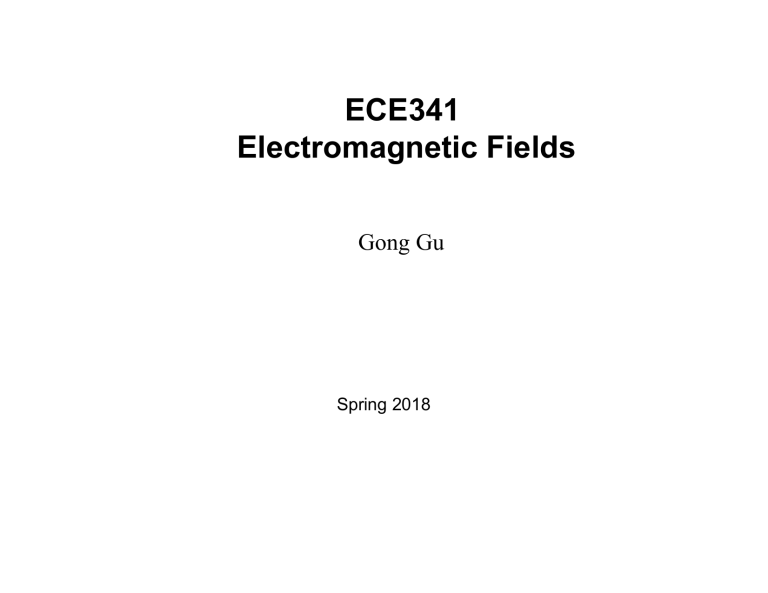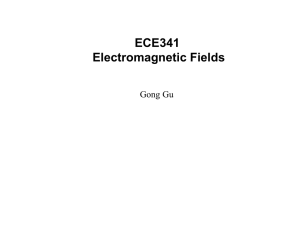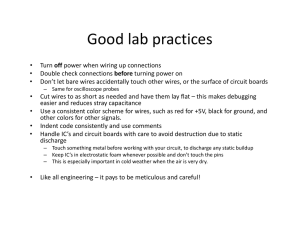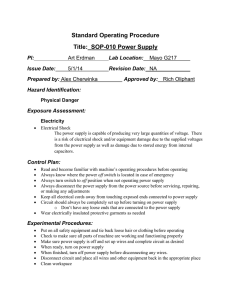
ECE341 Electromagnetic Fields Gong Gu Spring 2018 Introduction: Why EM Fields? The electromagnetic force is one of the four fundamental forces of Nature. (What are the other three?) Charged particles interact by the EM force, via EM fields. But why do we (electrical engineers) care? Circuit theory is a simple part of EM (black boxes: lumped components) Inside the black boxes: J = enE V E, J = E = I/A Velocity Force? What about Newton’s laws? I = V/R (Scattering. ~ 1015 s) Q Cv = CEd dv/dt dQ/dt i i = C dv/dt When f is really high (optical), the distinction between R and C is fuzzy. We don’t use circuit models there. Bi di/dt dB/dt E v Changing B field induces E Even a wire (or a pair of wires) is an inductor! v = L di/dt “Lumped” components when dimensions << wavelength Simplest example: a pair of wires (considered ideal wires) (the term “transmission line” is a bit confusing) Length << Length >> , say, infinitely long Voltage along a cable can vary! f Comments 60 Hz 5000 km Power 600 kHz 500 m Medium wave AM radio 0.3 GHz 1m 1.5 GHz 20 cm CPU clock rate 30 GHz 1 cm Data communication 300 GHz 1 mm f = c, c = 3 × 108 m/s microwave This course is about electromagnetics (EM), the foundation of Electrical and Computer Engineering, or, how electricity really works. -- Look into the black boxes. • Circuit theory is a simple model of EM, so it was taught first. • However there are an increasing number of cases where circuit theory fails (e.g. faster computers, higher communications frequencies, power electronics, power system transients,), and EM must supplement circuit theory. But, don’t worry… • Also EM is the basis for many devices (machinery, antennas, etc.), and one of the physical foundations of any active electronic device. • Serious hazards for electrical and computer engineers in all areas, such as interference and non-ideal behavior of circuit elements, are increasing with the higher frequencies today for Electrical and Computer Engineers in all areas. Read this introduction again at the end of the semester after we have presented all the material. You will have a deeper understanding and a delight from it. Textbook: Ulaby et al, Fundamentals of Applied Electromagnetics (7/E or 6/E) “Modern” sequence to teach the material: start with transmission lines based on a version of “circuit theory” Relax the requirement of previous knowledge in physics, and get students into it. Recommended reference books: Ramo et al, Fields and Waves in Communication Electronics Old school, rigorous. Start from “true” field theory – Maxwell’s equations A bit hard on today’s students, but it’s a good thing. Inan, Inan, and Said, Engineering Electromagnetics and Waves Another modern book in the same sequence as our textbook. Useful additional insights (one example) Jackson, Classical Electrodynamics A classic for physicists and microwave, optical engineers (The word “classical” in the title has a slightly different meaning.) Classics are not easy to read. A different unit system is used, which we engineers may not be used to. (Some equations look different, unlike elsewhere in physics, where different unit systems give you the same equations but only “different” physical constants.) Venture it only if you are really into this field after this course. Stare at this picture. See the difference? The picture we are more “used to”: About the class time Do you like the Daylight Saving Time? Will start at 8:15 am, and, accordingly, end at 9:30. Open to further push after Daylight Saving Time begins. Requirements & Evaluation Homework To be finished at the start of class on certain days, indicated in the schedule. Not graded. For your exercise. Do it first, and then check against my answers online. Not the other way! Quizzes Random, in-class. Graded. Tests Partially reflect homework and are certification that you learned what you should from the homework and study. Two major tests, on the days indicated in the schedule. Lab (3 labs) Completion of all labs is required for course completion. Submit report on time. Grade Test 1: 20%; Test 2: 20%; Quizzes: 10% Lab: 15%; Final exam: 35% Schedule The syllabus is online, as well as this introduction presentation and all class notes. The schedule is subject to changes, so check it often. Homework may require knowledge not covered in class at the time. Read the book on your own and do it. This is in preparation of the next class. Website http://web.eecs.utk.edu/~ggu1/files/UGHome.html Extra project for Honors class ECE347 Tips How to do well in this course (and others) and prepare to be a successful engineer: • Don't overload your schedule with courses and/or work; • Aim toward becoming a good engineer; • Don't miss classes (and the quizzes); • See lab as an inquiry - not following a cook book; • Study daily, not just the four nights before tests; • Ask questions, take notes; • Don't rely on somebody else (or my answer sheets online) for homework. • Pursue understanding of the principles - not just memorizing the symbols in some homework problems and equations; • Try to visualize phenomena - don't just manipulate math symbols; • Relate this material to other courses. • Revisit and reinforce the above three during the course, and, in your future study (e.g. read this Introduction again at end of course). • Read ahead, think in practical terms; see if using the book's CD helps. Topics off the topic Artificial intelligence and future engineering jobs (How to make you irreplaceable by machines) AlphaGo defeated best human players (old news now). Now there’s AlphaGo Zero A plumber working in my basement Computers recognize cats Human babies recognize cats Features of this course • • • • • Not so “structured” as you might expect Learn how to define your problems Foster curiosity, the habit of thinking (as humans as opposed to machine) Pursue true understanding, not mimicking When you understand the why, the how will come to you naturally • Lectures often take different approaches than does the textbook • Class is long; will try not to bore you (but you need to put down your phones) • Frequent, random in-class quizzes to keep you engaged • Not easy to fail Overview of course • General concept of waves • Transmission line theory derived from circuit theory (Yes, it works.) • Electrostatics (We start to discuss the “real” EM theory.) • Magnetostatics • Dynamic fields (Nothing in the world is “static”. In general, not just the static fields with time variation. There is “dynamics,” although sometimes the “quasi-static” picture works) • EM plane waves (The simplest EM waves. You get a sense how waves arise from dynamic fields) This course is about the fundamentals. More cool stuff (waveguides, antennas, etc.) will be covered in advanced courses: • ECE 443 - Antenna Systems Engineering • ECE 444 - Microwave Circuits • Graduate courses: ECE 541, 545, 546, 547 Question: For the string, you see the displacement is voltage different at each point (1). If you measure the instantaneous v between the two wires in a “transmission” line at two locations 1 ft apart, will the two v’s be different? Answer for both cases (2,3). If yes, how can a wire sustain the voltage difference? (1) Mechanical wave on a string (3) Coaxial cable “transmission line” Carries f’s up to 1GHz (2) Power transmission line



